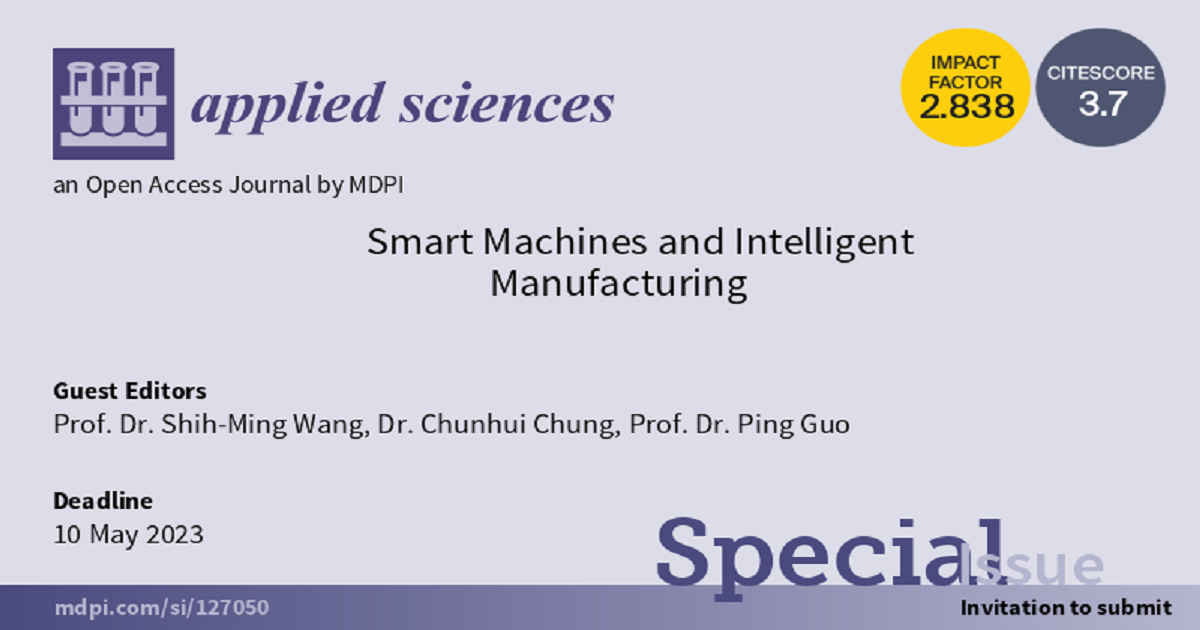Smart Machines and Intelligent Manufacturing
A special issue of Applied Sciences (ISSN 2076-3417). This special issue belongs to the section "Mechanical Engineering".
Deadline for manuscript submissions: closed (10 May 2023) | Viewed by 37463

Special Issue Editors
Interests: smart manufacturing; on-line intelligent monitoring and control; error measurement and compensation; machining dynamics and application; precision machine design and analysis
Special Issues, Collections and Topics in MDPI journals
Interests: smart manufacturing; machining; abrasive machining; computer-aided manufacturing
Interests: micro/meso-scale manufacturing; computer-vision-based metrology; micro-additive manufacturing; micro-structured functional surfaces; structural coloration; elliptical vibration texturing
Special Issue Information
Dear Colleagues,
As the concept of Industry 4.0 has become widely implemented in the manufacturing industry with modern technologies such as AIoT, sensing technology, information technology, artificial etc., it has led to significant changes and possibilities in the methods, tools, and systems supporting the machines and factories of the future. This Special Issue on Smart Machines and Intelligent Manufacturing (SMIM) provides a platform for the review and discussion of theoretical advances, research results, and industrial experiences among scientists, researchers, industry experts, and users dealing with the issues of Smart Machines and Smart Manufacturing.
This Special Issue welcome articles with original ideas and high-quality research outcomes on smart machine development and performance enhancement for manufacturing processes such as machining, forming, additive manufacturing, auto assembly, digital manufacturing, and quality measurement, with a view to practical implementation, including industrial case studies and original solutions. Original research contributions and reviews are invited for this Special Issue.
Prof. Dr. Shih-Ming Wang
Dr. Chunhui Chung
Prof. Dr. Ping Guo
Guest Editors
Manuscript Submission Information
Manuscripts should be submitted online at www.mdpi.com by registering and logging in to this website. Once you are registered, click here to go to the submission form. Manuscripts can be submitted until the deadline. All submissions that pass pre-check are peer-reviewed. Accepted papers will be published continuously in the journal (as soon as accepted) and will be listed together on the special issue website. Research articles, review articles as well as short communications are invited. For planned papers, a title and short abstract (about 100 words) can be sent to the Editorial Office for announcement on this website.
Submitted manuscripts should not have been published previously, nor be under consideration for publication elsewhere (except conference proceedings papers). All manuscripts are thoroughly refereed through a single-blind peer-review process. A guide for authors and other relevant information for submission of manuscripts is available on the Instructions for Authors page. Applied Sciences is an international peer-reviewed open access semimonthly journal published by MDPI.
Please visit the Instructions for Authors page before submitting a manuscript. The Article Processing Charge (APC) for publication in this open access journal is 2400 CHF (Swiss Francs). Submitted papers should be well formatted and use good English. Authors may use MDPI's English editing service prior to publication or during author revisions.
Keywords
- smart machine
- intelligent manufacturing
- sensing technology
- artificial intelligence
- machining
- additive manufacturing
- digital manufacturing
- quality measurement
- CPS
Benefits of Publishing in a Special Issue
- Ease of navigation: Grouping papers by topic helps scholars navigate broad scope journals more efficiently.
- Greater discoverability: Special Issues support the reach and impact of scientific research. Articles in Special Issues are more discoverable and cited more frequently.
- Expansion of research network: Special Issues facilitate connections among authors, fostering scientific collaborations.
- External promotion: Articles in Special Issues are often promoted through the journal's social media, increasing their visibility.
- Reprint: MDPI Books provides the opportunity to republish successful Special Issues in book format, both online and in print.
Further information on MDPI's Special Issue policies can be found here.







